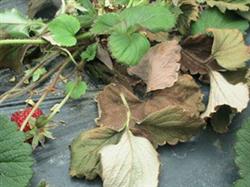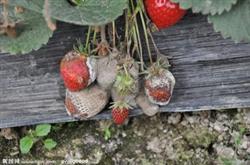Harm and comprehensive control of strawberry Verticillium wilt

Strawberry Verticillium wilt is a soil-borne disease. It is an important reason that affects and perplexes the expansion of strawberry production in recent years. Because strawberry is a perennial plant, after continuous planting in the same field for many years, resulting in a large number of bacteria accumulation in the soil, coupled with the decline of variety resistance, poor field management and other factors, the incidence of strawberry Verticillium wilt increased year by year. It has become an important disease in strawberry production. Strawberry Verticillium wilt mainly occurs in the stolon stage, invading from the root and showing symptoms above ground. The new leaves of the diseased seedlings lost green and turned yellow or curved, the leaves were narrow and boat-shaped, the bilateral leaflets on the compound leaves were asymmetrical and deformed, most of them hardened and the leaves were yellowed. The diseased plant grew poorly, was lifeless, the leaf surface was rough and dull, withered and browned from the leaf edge, and finally the plant withered. The vascular bundles of underground roots, petioles and stems browned or even blackened. The effect of chemical control on strawberry Verticillium wilt is not good, so attention should be paid to the application of comprehensive control measures. ① selected healthy plants from disease-free land to plant disease-free and healthy seedlings. The disease-free mother plant can be obtained by collecting seedlings in space, that is, cutting the stolon before landing on the ground, inserting it into the disease-free soil and making it take root, which can be used as a mother plant to raise seedlings. ② avoids continuous cropping and implements rotation for more than 3 years. Soil disinfection and sterilization should be strictly carried out before sowing or planting of ③. The method is 667 square meters with chloropicrin 13.5 to 20 liters, hole application or ditch application, cover the soil film after application, release gas after removing the film, and can not raise seedlings or colonize until there is no drug damage; it can also be sterilized by solar energy, choosing the high temperature period in July to turn deeply and irrigate, cover the plastic film, and use high temperature under the film to sterilize. ④ strengthens cultivation and management measures. Note that after strawberry planting, the soil should not be too dry or too wet; remove diseased old leaves in time; if diseased plants are found, they should be pulled out and replanted as soon as possible, buried or burned, so as to reduce the source of bacterial infection. Before or at the beginning of ⑤ planting, 70% methyl topiramate wettable powder 300 × 500 times solution was used to soak the roots for disinfection or irrigation roots after planting.
- Prev

Control techniques of pollution-free Diseases and insect pests of Strawberry
Symptoms: strawberry black mold is mainly harmful to nearly mature fruit, if the harvested fruit is not processed and packaged in time, it is more likely to be infected, resulting in a large number of fruit rot. At the beginning of the disease, the fruit showed a light brown water-immersed disease spot, and then quickly softened and rotted, growing gray cotton, upper granular black mold, that is, mycelium and seeds.
- Next

How to prevent and cure strawberry black heart
Symptoms of strawberry black heart disease: the first inflorescence, heart leaves, fruit stalks and petioles are so short that they cannot be extracted, the flowers bloom abnormally at the base, and the leaf edges of the new leaves dry and turn black. Serious first inflorescence and new leaves all dried up and turned black, farmers call it "black heart disease". Prevention and control measures: 1, reduce chemical fertilizer.
Related
- Moge, come on! The staff of the peasant association in the producing area of cantaloupe were frightened when the crowd gathered.
- Causes and Solutions of low Fruit setting rate of Apple
- Symptoms and control measures of passion fruit virus disease
- Fruit growing lesson: how do apple orchards keep high yields?
- Can you build orchards in the mountains? What are the pros and cons?
- How to manage the coloring period of Crisson grape?
- This paper introduces the processing technology of two kinds of fig products.
- How much is a month for retired teachers in rural areas by 2020?
- How can strawberry planting increase sugar content? We should pay attention to management in many aspects.
- What are the cultivation techniques on how to improve the yield of golden fruit?

